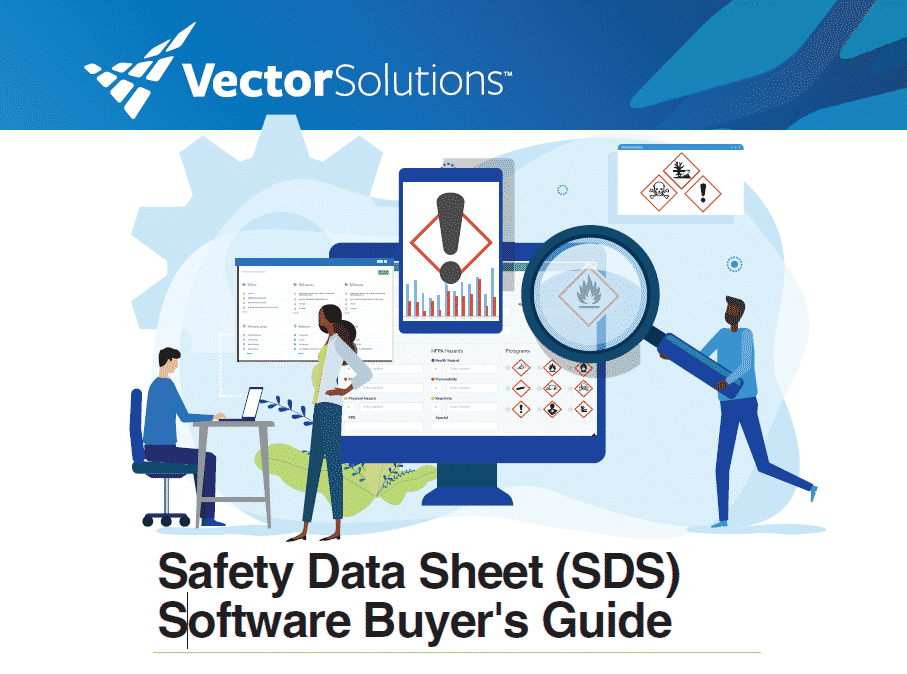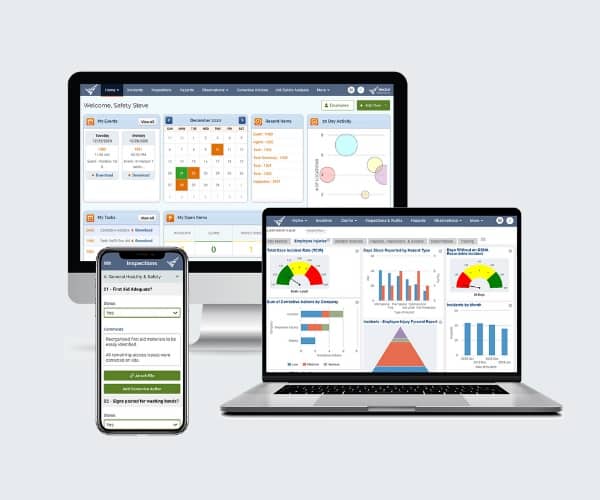November 2, 2023 6 min read
Industrial Hygiene: What is a Permissible Exposure Limit (PEL)?
Industry:
Solution:
What Is a Permissible Exposure Limit (PEL)?
A permissible exposure limit, also known as a PEL, is a limit for an employee’s exposure to (most commonly) hazardous chemicals but also to other harmful agents such as noise. OSHA sets PELs as the legal requirement in the United States.
OSHA has established PELs for hundreds of hazardous chemicals. Most of these PELs are found in the OSHA 1910.1000 Z Tables–Z1, Z2, and Z3.
You’ll find OSHA PELs for noise in 1910.95, Occupational Noise Exposure.
PELs are typically given as a time-weighted average, or TWA. However, they are sometimes given as short-term exposure limits (STELs) or ceilings.
What Is a Time-Weighted Average (TWA)?
The time-weighted average, or TWA, is an average exposure level over a specific time.
Here’s how OSHA explains the TWA:
The average exposure to a contaminant over a given period of time, typically 8-hours.
What Is a Short-Term Exposure Limit (STEL)?
A short-term exposure limit, or STEL, is an average exposure limit over a short time.
Here’s how OSHA explains the STEL:
The average exposure to a contaminant to which a worker may be exposed during a short time period (typically 15 – 30 minutes).
What is a Ceiling Limit?
A ceiling is a maximum allowable exposure limit. It’s not an average exposure limit over time, like the TWA and STEL, but a maximum exposure at any one time.
Here’s how OSHA explains a ceiling limit:
The exposure limit a worker’s exposure may never exceed.
OSHA goes into more detail on ceiling limits here:
Substances with limits preceded by “C”-Ceiling Values. An employee’s exposure to any substance in Table Z-1, the exposure limit of which is preceded by a “C”, shall at no time exceed the exposure limit given for that substance. If instantaneous monitoring is not feasible, then the ceiling shall be assessed as a 15-minute time weighted average exposure which shall not be exceeded at any time during the working day.
Does An Employer Face Any Responsibilities for Exposures Below the PEL?
Yes, the employer does have specific responsibilities even when exposures are below the PEL. These requirements from OSHA kick in when exposure limits reach what’s known as an action level.
Here’s how OSHA explains an action level:
Action level means a concentration designated in 29 CFR part 1910 for a specific substance, calculated as an eight (8)-hour time-weighted average, which initiates certain required activities such as exposure monitoring and medical surveillance.
Action Level Examples
Action levels trigger specific activities for exposure monitoring and medical surveillance. Here are a few practical scenarios where action levels come into play, triggering essential measures for exposure monitoring and employee protection:
- Noise Exposure:
- Action Level: 85 decibels (dB) over an 8-hour TWA
- Implication: Once noise exposure averages 85 dB over an 8-hour period, employers must conduct noise monitoring, implement controls, and offer hearing protection.
- Dust Concentration:
- Action Level: 5 milligrams per cubic meter (mg/m³)
- Implication: When airborne dust concentration reaches 5 mg/m³, employers must begin exposure monitoring and implement measures to reduce exposure.
- Chemical X:
- Action Level: 20 parts per million (ppm)
- Implication: When employee exposure reaches 20 ppm, employers initiate regular exposure monitoring and implement medical surveillance measures.
Action levels play a crucial role in maintaining a proactive approach to workplace safety. By setting specific thresholds, they prompt employers to monitor and address potential hazards before they escalate, ensuring a safer environment for employees and reducing the risk of long-term health issues.
SDS Software Buyer's Guide
Download
Are OSHA’s PELs Outdated?
OSHA created most of its PELs shortly after OSHA came into effect in 1970, and even OSHA admits many of them are outdated, meaning the OSHA PELs often don’t reflect current knowledge of hazardous exposure levels and that the OSHA PELs are often set much higher than they would be in an ideal circumstance.
Here’s how OSHA puts it:
OSHA recognizes that many of its permissible exposure limits (PELs) are outdated and inadequate for ensuring protection of worker health. Most of OSHA’s PELs were issued shortly after adoption of the Occupational Safety and Health (OSH) Act in 1970, and have not been updated since that time. Section 6(a) of the OSH Act granted the Agency the authority to adopt existing Federal standards or national consensus standards as enforceable OSHA standards.
Nonetheless, the OSHA PELs found in OSHA regulations (and mainly within the 1910.1000 Z Tables) are still legally binding, and they essentially set a minimum compliance standard for employers.
If OSHA PELs Are Out of Date, Should Employers Comply With Other Occupational Exposure Limits?
OSHA not only acknowledges that many of its own PELs are out of date and not adequately protective, they also suggest employers consider using more modern, updated occupational exposure limits set by other organizations. Again, here’s how OSHA puts it:
Industrial experience, new developments in technology, and scientific data clearly indicate that in many instances these adopted limits are not sufficiently protective of worker health. This has been demonstrated by the reduction in allowable exposure limits recommended by many technical, professional, industrial, and government organizations, both inside and outside the United States. Many large industrial organizations have felt obligated to supplement the existing OSHA PELs with their own internal corporate guidelines. OSHA’s Hazard Communication standard (1910. 1200 Appendix D) requires that safety data sheets list not only the relevant OSHA PEL but also the ACGIH® TLV® and any other exposure limit used or recommended by the chemical manufacturer, importer, or employer preparing the safety data sheet.
To provide employers, workers, and other interested parties with a list of alternate occupational exposure limits that may serve to better protect workers, OSHA has annotated the existing Z-Tables with other selected occupational exposure limits. OSHA has chosen to present a side-by-side table with the Cal/OSHA PELs, the NIOSH Recommended Exposure Limits (RELs) and the ACGIH® TLVs®s. The tables list air concentration limits, but do not include notations for skin absorption or sensitization.
Watch for future articles by us explaining RELs, TLVs, and similar exposure limits.
Challenges in PEL Compliance
Compliance with Permissible Exposure Limits (PELs) poses significant challenges for employers committed to workforce well-being. The complexity of exposure monitoring in dynamic workplaces demands sophisticated tools and strategies. The variability in work environments across industries requires tailored approaches to address specific risks, complicating the development and implementation of effective exposure control measures.
Challenges in Compliance:
- Dynamic Work Environments: Monitoring exposure levels becomes intricate in workplaces with diverse tasks and varying environments.
- Industry-Specific Variability: Compliance challenges differ significantly between industries (e.g., manufacturing vs. construction), necessitating industry-tailored solutions.
- Employee Training and Turnover: Consistent training efforts are essential, especially in industries with high turnover rates, requiring continuous education on PELs and safety measures.
- Resource Constraints: Limited resources may hinder the implementation of adequate controls, such as engineering solutions or personal protective equipment.
- Updating Safety Measures: Ongoing review and updates are necessary as workplaces evolve, posing challenges in keeping safety protocols current and aligned with industry standards.
- Integration with Other Safety Programs: Harmonizing PEL compliance with broader safety initiatives introduces complexities, requiring a careful balance between different safety goals.
Overcoming these challenges demands a holistic and adaptable approach that prioritizes both regulatory requirements and the health of the workforce. Employers must navigate these obstacles to foster a safety-conscious culture, where employees actively participate in maintaining a safe work environment.
Conclusion: Industrial Hygiene (IH) Basics: Permissible Exposure Limits (PELs)
We hope you found this Industrial Hygiene Basics article on the permissible exposure limits (PELs) by OSHA helpful.
To learn more about this IH topic and other IH topics, check out our Industrial Hygiene Basics elearning course–we’ve provided a short sample below or you can click the link you just passed for more information.
This IH Basics article, and all our IH Basics articles, has been created in collaboration with Morgan Bliss, a Certified Industrial Hygienist and an Assistant Professor of Safety Management at Central Washington University. We’d like to thank Morgan for her expertise and we encourage you to visit Morgan Bliss on LinkedIn.









